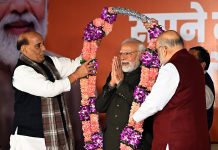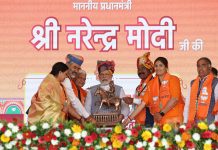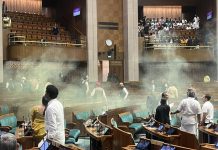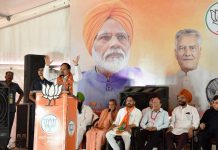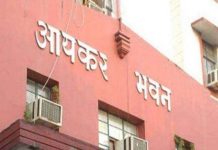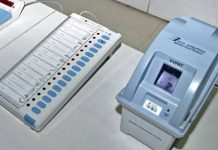 The elections in Tripura seemed more of an ideological fight between the Right and the Left than an electoral one. The CPI(M) had certainly gone astray in this fight. In the era when BJP is blatantly expanding its
The elections in Tripura seemed more of an ideological fight between the Right and the Left than an electoral one. The CPI(M) had certainly gone astray in this fight. In the era when BJP is blatantly expanding its  the CPI(M) is enthralled in discussing whether Prime Minister Narendra Modi’s rule conforms to authoritarianism or fascism, or whether the CPI(M) should have a tactical alliance with the Congress. The results have proven that it was not enough to project that the people of Tripura would reject communal politics. It has been four years since the BJP government came in at the Centre, but various sections of society are still enamoured by PM Modi despite his myriad failures. The party has continued to grow electorally as well as ideologically. The party went about building individual party wings for the youth, women, SC, ST, OBC, minorities and farmers. Vistaraks were appointed to ensure there was no infighting and any dissidence did not brew to the surface. ‘Panna pramukhs’ were given one page each out of a 17-18 page voter list. Each page has a list of 60 voters. The ‘panna pramukh’ was supervising the needs of each of the 60 voters.
the CPI(M) is enthralled in discussing whether Prime Minister Narendra Modi’s rule conforms to authoritarianism or fascism, or whether the CPI(M) should have a tactical alliance with the Congress. The results have proven that it was not enough to project that the people of Tripura would reject communal politics. It has been four years since the BJP government came in at the Centre, but various sections of society are still enamoured by PM Modi despite his myriad failures. The party has continued to grow electorally as well as ideologically. The party went about building individual party wings for the youth, women, SC, ST, OBC, minorities and farmers. Vistaraks were appointed to ensure there was no infighting and any dissidence did not brew to the surface. ‘Panna pramukhs’ were given one page each out of a 17-18 page voter list. Each page has a list of 60 voters. The ‘panna pramukh’ was supervising the needs of each of the 60 voters.
Apart from a social media team of young people fluent in English, Bengali and Kokborok, some 400 vistaraks were brought in from Assam in the final leg of the campaign. Apart from this, the BJP carried an arsenal containing all sorts of uncivil and anti-humanitarian weapons to gain victory. The Left’s campaigning was not modernised in a way it should have been. The Left front ran a door to door old-school campaign. Even the rigorous social media of CPI(M) campaign started quite late as compared to BJP. The ‘CPI(M) model of governance’ wasn’t sold well even though the party ruled Tripura for 25 years. The Left clearly had no counter to the vicious communal and sectarian campaign of the BJP.
The honest and austere image of CM Manik Sarkar certainly helped extending CPI(M) rule in Tripura but all it took to fail that was the BJP’s more powerful appeal — “The PM is much bigger than the CM and he will care for you too if you vote his party.”
BJP won the election by aligning with an outfit which operates from Bangladesh, a terrorist organisation which surely do not go with the RSS preaching of nationalism. But it is also true that the BJP had infiltrated into the CPI(M) voter base to a very great extent. The contest between the candidates was too close. In several constituencies like Matarbari, BJP gained votes because CPI(M), CPI(ML) and SUCI(C) were contesting against each bother instead of consolidating anti-BJP votes. Had there been a Left+Congress alliance, it would not have guaranteed victory for Sarkar but it could have brought the constituencies of Amarpur, Bamutia, Belonia, Karbook, Pencharthal, Nalchar, Panisagar in Left’s kitty, increasing its tally to around 22 seats. The CPI(M) was expected to drive the BJP, electorally as well as ideologically, out of Tripura by forging an umbrella of alliances with social movements, anti-BJP parties and organisations but this didn’t happen. Instead, the present and former general secretaries of the party were busy debating a tactical line.
The defeat of Left in Tripura was neither a question of Caste and Communal polarisation nor the same 2014 anti-incumbency situation that toppled the Congress. The Left front ruled Tripura for more than 25 years, which is possibly more than the total cumulative tenure of any BJP regime that has existed at the Centre+States in Indian history. The honest chief minister Manik Sarkar did not succeed in keeping up with the towering ambitions of the same people who were brought up through his social welfare. The Tripuri populace got education, ration, healthcare, and also a society free of political and communal violence under the Left Front government. With increased levels of literacy and the spread of educational opportunities, the aspiration of the tribals, particularly the youth, increased manifold. But the government failed to provide them the lifestyle they have now started desiring. However, within the given structure of political economy it was not feasible for any government to meet those aspirations.
There was indeed the problem of unemployment, but the tiny state of Tripura wasn’t the only state affected by it. We must not forget the fact that we are living in times when our Prime Minister considers ‘Pakoda selling’ as aspirational
employment. There is another aspect which cannot be ignored and that is the limitations of a tiny backward state government with a hostile Central government in the neoliberal era, though that’s another debate. But yes, Tripura had definitely become a bit rusted when it came to the standard of living in comparison with Kerala, another Left-ruled state. Manik Sarkar had nurtured the insurgency-affected state to normalcy and economic stability but after that could not catch up well on the economic front. If Kerala could do so much in so little time, Tripura could also have done the same. As things stand now, the CPI(M) or the Left Front is confined to the single state of Kerala.
As per public opinion, bagging 35 seats in Tripura wont have any impact on national politics since there are chances that BJP might face debilitation in Karnataka, Rajasthan and Madhya Pradesh which won’t be covered by this gain. But we now know that Left is not going to be an important player in fighting Fascism and Kerala being an exception, it evidently cannot win a straight contest with the BJP anymore. The constituencies of the Left are not ideologically aligned to the Left or betrothed to vote Communism as it used to be earlier in East India. A new program has to be adopted, and a new state like Bihar or Tamil Nadu with a strong communist history has to be focused upon for the growth of the party. The CPI(M) being down to one state is historically the worst situation ever. A tribal sectarian political outfit known as INPT, which was ally of Congress in 2013, wanted to join hands with CPI(M) this time but the former refused their offer. The CPI(M) exclusively fought election with Left ideology, without any alliance. It’s understandable that Congress has been CPI(M)’s main opponent in West Bengal, Kerala and Tripura but the party has limited itself as a state-level force by not intervening at the national stage, and not adopting a broader vision for the big fight is immature for the party struggling with “ideological concerns”.
The Tripura verdict has come as a major lesson and should be considered a defeat of stubborn ideological purism. It is the defeat of the strategy of trying to take on a mountain alone; the defeat of the possibility of a united Opposition.
Not only CPI(M) but the whole opposition representing different interests is in danger of losing their relevance. If the CPI(M) can seek forgiveness from the people of West Bengal then it should also try to forgive Congress for its failures. It must shed its inhibitions against the Congress for the greater cause of this country as they neither have the individual strength nor the resources to take on their rivals. The arguments put forward by those against the idea of a broader coalition even after Tripura results emphasises that these theoreticians lack utmost practicality. If the party is refusing to have an electoral understanding with the Congress, it shouldn’t expect a united fight against the BJP. The current line of CPI(M) benefits none other than the BJP and the RSS.
Modi taunted the Left party after Tripura victory by saying “Sun is red when it sets, turns saffron when it rises”. However, he didn’t realise the fact that every rising Sun sets in the end. In these adverse political and social circumstances, there is fertile ground for the Left parties to bounce back to relevance. The Left doctrine states that with the rise in discrimination and exploitation, the society will be split into two groups — the oppressor and the oppressed. The numerically larger oppressed will then unite and through their agitations, uproot the oppressor. But for this to succeed, the Left needs to be in a position to lead. If the Left is serious about the future of India’s politics and democracy, it needs to leave no stones unturned in trying to unite the Opposition. It is important to note that Prakash Karat in an interview to The Hindu was skeptical of the fact that there will ever be an understanding between SP and BSP. However, the recent political understanding between Samajwadi Party, BSP and all the Left parties to support the SP candidate for Gorakhpur and Phulpur Lok Sabha constituencies debunks his myth. The consistent sharpening left-right polarity at the state level in Kerala, Tripura and perhaps West Bengal too might make it easier for the CPI(M) and the Congress to come closer together nationally in the wake of preventing the BJP from winning the Lok Sabha elections once more in 2019. Politics is changing in the South. For example, Telugu Desam Party is feeling marginalised because PM Modi failed to keep the promises he made to Chandrababu Naidu. A regional party like TDP could be aligned with to cobble together a larger united front. However, the Tripura election result is a reminder of the limits of alliance building. If the CPI(M) is weakening, it is the Congress which is likely to ask what it will gain by tying up with the Left rather than the other way around.
The CPI(M) has lost in Tripura but it still was the single largest party with a dip in vote share of just 3 per cent as compared to previous elections, which means that the Party has been defeated, and not destroyed. It’s high time they increase their political strength and mass base, so as to provide a viable alternative national leadership. Additionally, it is time for the theologists to step aside and let mass leaders take over. Learning from its experiences, unless the CPI(M) starts to think politically rather than ideologically, the trend in Tripura will eventually lead to the West Bengal path. The attempt for a wider coalition is not only necessary for putting a halt to BJP’s ascent but also for strengthening future of the Left and the country’s democracy. Otherwise the future of the Communist Party of India (Marxist) is going to be scripted as Communist Party Of Kerala.
letters@tehelka.com

